The life of yard dogs takes place on the street, therefore, their appearance, activity, health depends on the quality of the kennel. The insulated kennel for the dog provides uniformity of temperature, does not allow heat leakage through the floor, walls, roof.
- The need to insulate the booth
- Warming rules
- Temperature, insulation thickness
- Materials for warming a dog kennel
- Insulation of the booth for the winter from the inside
- Insulating a dog house outside
- Ways to insulate a doghouse for the winter
- Electrical insulation
- Step-by-step instruction
- Wall insulation
- Insulation of the floor from the cold
- Protective shutter for the entrance manhole
The need to insulate the booth
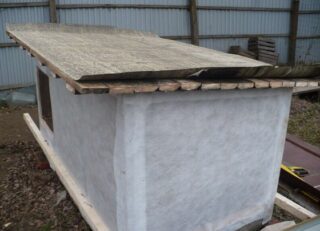
The conditions of detention depend on the climate, the breed of the pet. Different types of dogs react to cold differently:
- Animals with short hair, long fur and a powerful undercoat painlessly tolerate frosts down to -40 ° C. For example, the Moscow watchdog, husky, Bernese mountain dog sleep in the snow, stay in the yard when the cold comes.
- Dogs who do not have a thick undercoat need mild conditions so that they do not get sick.
The ability to withstand frost also depends on the previous living conditions. Pets previously kept indoors are more difficult to tolerate the cold. In warm weather, molt is more intense, the undercoat is thinning.
Warming rules
The animal's house is not placed directly on the ground, since the bottom is cooled from the frosty soil. For this, wooden blocks or ceramic bricks are provided. A layer of air will conserve internal energy. The booth is assembled from wood, since the material does not conduct heat well.
Basic rules for insulation:
- the manhole is located on the leeward side to reduce drafts;
- the inlet is covered with a canopy of dense material;
- waterproof the roof so that there are no leaks, there must be a dry litter inside;
- insulate all enclosing surfaces (walls, ceiling, floor).
The tambour retains heat well, prevents wind blowing. A warm booth with an extension will protect the dog from precipitation, it will not freeze while eating, since the drinker and bowl are placed in the area of the additional wing. Provide for one of the acceptable options for heating the kennel.
Temperature, insulation thickness
The pet heats up the unheated room due to the heat of its body. Temperature in dogs is considered normal in the range of 38.5 - 39 °. Inside, there should be about the same level that is provided by insulation.
The thickness of the insulating layer depends on the type of material. All types have different indicators of thermal conductivity, different degrees of moisture saturation. The insulation gets wet from the direct action of precipitation or soil moisture, absorbs condensation drops from the difference between the internal and external temperatures. A damp insulator no longer protects against the cold.
Materials for warming a dog kennel
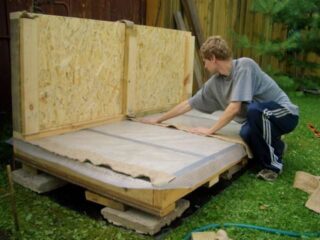
All materials must be covered with plywood, boards, OSB boards, chipboard and other rigid panels. The materials of a warm booth for a dog must meet the following requirements:
- Ecological cleanliness. This is especially true of the inner layers, the secretions of which the dog will breathe.
- Minimum saturation and water retention. For example, mineral wool is protected from condensation by waterproofing, while creating a ventilated drying gap.
- Strength. This also applies to the canopy, which the dog regularly moves with the body when exiting and entering.
Different materials are used for the inner and outer layers.
Insulation of the booth for the winter from the inside
Insulators made of natural material are installed inside. There is an effective insulation consisting of flax and additives (85 and 15%, respectively). The material is flammable, but special components in the composition reduce the dangerous quality.
Other types of internal insulation:
- Felt. Refers to breathable pads, affordable and safe look. Nailed to surfaces with wide-headed nails. There is no need to additionally finish with plywood.
- Soft fiberboard plate. An environmentally friendly look is made from small sawdust, wood fibers. Has a low heat conductivity, good vapor permeability. Due to the latter property of the slab, the humidity in the booth is regulated.
Roll insulation is also used, for example, polyethylene foam, foil types of foam foam, polyurethane foam. They are placed with the shiny side inside the kennel.
Insulating a dog house outside
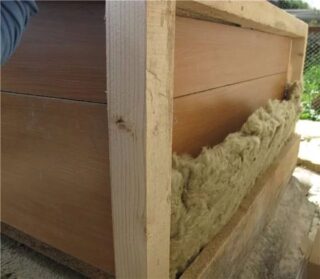
They use moisture resistant types and insulation that can absorb water. They are protected with a film, an additional crate is placed. Outside, such a "cake" will be appropriate, but inside it will take up a lot of space.
Other types are used:
- Styrofoam;
- expanded polystyrene.
Insulation joints are sealed with polyurethane foam for outdoor use. There is an option to foam the entire outer surface of the walls.
Ways to insulate a doghouse for the winter
Use fabric mattresses or make warm bedding. A cover is put on the pillow or mat, which is regularly removed and washed. Such bedding, in addition to washing, requires drying in the open air, treatment of fleas with non-toxic agents for animals.
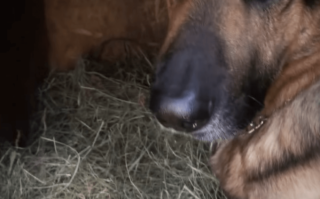
There are many options for insulation, the choice is up to the owner of the dog.
- Straw or well-dried hay is placed at the bottom of the kennel. For the winter period, you need to prepare a certain amount, since the material will have to be changed every week or shaken up. The straw is caked and damp over time. The owners speak negatively about the use of this method, because ticks parasitize in the litter. Better to take thyme, sage, wormwood.
- The foam is not saturated with moisture, therefore it is ideal for insulating a kennel, but only from the outside. There is conflicting information about the health hazards of the material, so it is better to place it from the street so that the pet does not definitely breathe harmful components. The material is glued to the surface, from above it requires sewing with a finishing layer of plywood and boards. The seams are foamed to get rid of drafts.
- Mineral wool is represented by stone wool, glass wool and slag wool. All varieties are suitable for external frost insulation of walls. A vapor barrier is placed under the material, then a rack frame is made, onto which the material is nailed. An additional layer of additional lathing will be required to create a ventilation gap for drying the condensation drops and the cotton itself.
- Felt is placed on the walls, floor, roof inside the booth, since the non-toxic material will not harm the pet. It is made in a non-woven way, the raw material is the wool of goats, rabbits, which is dumped during the production process. The material has a uniquely low heat conductivity. A type of felt is felt, which is thinner, but retains all the characteristics of the main material.
Penoplex is used to insulate the booth inside and outside. It is produced on the basis of inorganic and organic polymers, produced by extrusion under pressure. Has a small thickness, nailed with hardware, a stapler, put on glue.
Electrical insulation
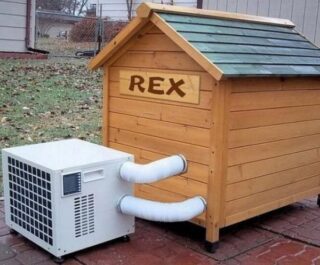
The method requires leading wires to the booth or using battery-powered equipment. You can insulate the booth with heated mats, the temperature can be set in the range of 35 - 70 ° С. The cover is made of polyethylene or moisture resistant fabric.
Installation takes little time, the rug is simply placed on the floor. The disadvantages are that the dimensions of the panel do not always coincide with the square of the bottom of the kennel.When fastening, it is difficult to correctly determine the location of the heating elements inside the mat.
Heating options:
- Panel method. The heater is silent in operation, the thickness of 2 cm will not take up space in the booth. The temperature rises to a maximum of + 50 ° С, does not dry out the air. The heating surface does not need to be covered with hard materials, the heater has a high degree of protection against fires and moisture.
- Cable heat-insulated floor. The system is placed in the floor, between two plywood boards; a temperature regulator must be placed in the frame. All welded areas, gaps are treated with silicone. Heating is connected in late autumn, a pet mat is laid on the floor.
Film thermal insulation in the form of an infrared membrane is energy efficient, evenly distributes heat in space, and does not dry out the air. Laminated film on both sides prevents damage. Before installation, place foil on the surface to reduce heat loss. Requires insulation with rigid panels, heats up to a maximum of + 60 ° C.
Step-by-step instruction
A removable roof is made in the booth in order to clean, change the litter without problems, and treat the inside from fleas. Attention is paid to the insulation of the seats of the opening structure, since they are bridges for the passage of cold air.
Wall insulation
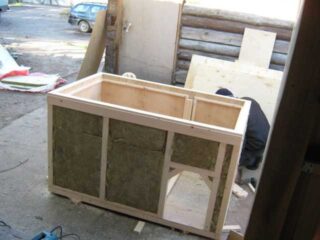
The process of installing an insulator depends on the type of material that is used for this.
General order of work:
- the walls are cleaned of debris, treated with antiseptics, use non-toxic drugs;
- fill the waterproofing membrane, if required by the insulator used;
- the insulation layer is glued to special compounds or nailed with hardware, a stapler;
- an additional vapor barrier film is installed on top;
- the walls are trimmed in a chosen way, for example, with boards, fiberboard panels.
When installing films, insulating material, blow-through cracks, gaps are not allowed, since drafts for an animal are more dangerous than cold. For internal surfaces, varnish, paint are not used; it is better to leave the plane in its natural state.
Insulation of the floor from the cold
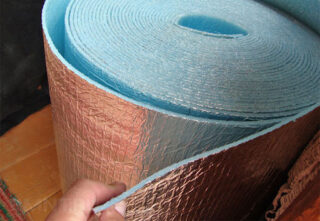
Sometimes the owners only use the bedding at the bottom of the booth. This option is acceptable in warm climates, where there is no severe frost. Outside, under the bottom of the kennel, a layer of roofing material is nailed to protect the plane from soil moisture. To do this, the booth is turned over in order to conveniently nail the material, the boards are impregnated with an antiseptic.
Inside, the floor is lined with glassine, it is laid with the plant on the walls (10 cm), the joints are overlapped. You can use only 2 layers, roofing felt, thick polyethylene. Fasten the insulation with a stapler or small self-tapping screws, can be glued on bitumen mastic.
Insulating material is laid, it is nailed with slats, on which a vapor barrier layer is laid. On top, boards of the final floor or chipboard panels, OSB are nailed.
A shallow pit (25 cm) is dug under a warm booth for a dog for making a cushion of sand and rubble (10 and 15 cm, respectively). Roofing material is laid on top of the bedding.
Protective shutter for the entrance manhole
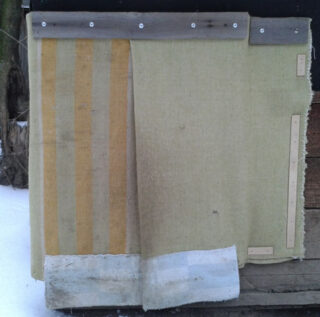
Most of the heat escapes through the hole. For the curtain, thick fabrics are taken, for example, tarpaulin, drape, wool, flannel blanket, you can put rubber, felt. Silicone curtains work effectively, which bend, do not deteriorate from frost, water and wind.
Sequence of work:
- two rectangles are cut out of the material, their length and width are taken 5 cm larger than the hole, an overlap of 4 cm is taken into account;
- the material is fixed on top of the holes, pressed with a wooden lath, the strips are placed overlapping one another so that there is no gap in the middle;
- from the sides, the curtain is also fixed with wooden slats all the way to the bottom, or the elements are placed only on the upper half.
The bottom of the canvas is made heavier by sewing on additional strips of material, metal plates, rods.This is necessary so that the halves of the curtain do not develop from strong winds.








